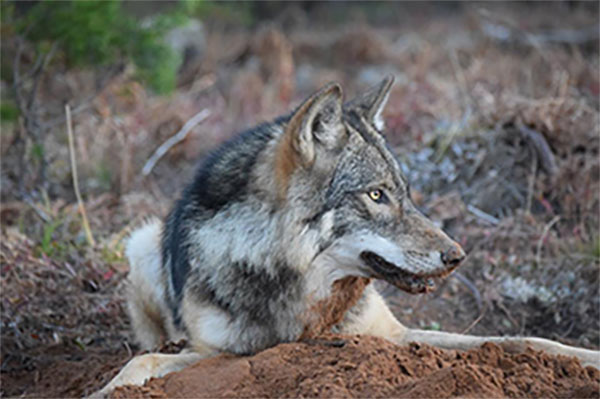MDNR Report
 Michigan Wolf
Michigan Wolf
Wildlife biologists from the Michigan DNR released their findings of the latest Michigan gray wolf survey.
The survey, conducted in early 2022, shows the wolf population in the Upper Peninsula remains stable, as it has for more than a decade.
“These results show a continued trend of statistical stability, indicating that gray wolves may have reached their biological carrying capacity within the Upper Peninsula,” said Cody Norton, the DNR’s wolf specialist. “Wolf presence has only been confirmed twice genetically in the Lower Peninsula in recent times; in 2004 and 2014.”
The survey, which is conducted every other winter, covers the U.P., including Drummond, Neebish and Sugar islands, with Isle Royale excluded. The wolves on Isle Royale are managed by the National Park Service.
Completing analysis of the field data collected during the DNR’s 2022 wolf survey was delayed during the past year as wildlife biologists focused on updating the state’s Wolf Management Plan.
The plan was updated using all pertinent social and biological scientific knowledge on wolves to date.
The minimum wolf population estimate from the 2022 survey is 631 wolves, plus or minus 49 wolves. A total of 136 packs was estimated with an average number of individuals per pack calculated at 4.5.
“Our minimum wolf population estimate is not statistically different from the last estimate in 2020,” Norton said. “All of the estimates since 2011 have not differed statistically.”
However, wolf density appears to have shifted over time.
“The density of wolves may have decreased in some areas of the west U.P. and increased in some parts of the east U.P.,” DNR wildlife biologist Brian Roell said.
This may be linked to significant winter weather events during 2013-2015, which greatly reduced deer densities in mid- and high-snowfall zones of the region.
Trending results
The wolf population in the U.P. showed mostly steady growth from 1989 to 2011. From 1994 to 2007, the population grew at an average annual rate of 19%. From 2003 to 2007, the average annual growth rate was 12%.
The growth rate was expected to decline as the population moved toward the maximum level the U.P. can sustain.
Since 2011, the minimum estimate for the wolf population has remained stable ranging from 618 to 695. A minimum of estimate of 695 wolves occurred in the U.P. during the winter of 2020.
Lower Peninsula
In October 2004, a wolf that had been captured and radio-collared in the eastern U.P. was captured and killed by a coyote trapper in Presque Isle County of the northern Lower Peninsula. This event represented the first verification of a wild wolf in the L.P. in at least 69 years. However, winter track surveys during 2005-2010 failed to indicate the presence of any wolves in the LP.
In 2014, biologists from the Little Traverse Bay Bands of Odawa Indians captured what appeared to be a wolf on a trail camera and were able to collect a scat sample. DNA analysis of the scat confirmed that the animal was a wolf. Although it is possible that wolves occur in the LP, but as of January 2023, no wolves are known to exist there.
New dashboard
The DNR has produced a new online dashboard, making incidence of wolf-dog conflicts more accessible for viewers. The dashboard includes mapped data points of conflicts and a database of incidents over many years.
The improvement in presenting the data was suggested during meetings in 2022 of the Wolf Management Advisory Council and sections of the recently update Michigan Wolf Management Plan.
Changing legal status
The legal status of wolves at both the federal and state level has changed several times, which impacts the ability of all agencies to manage wolves. Regardless of changes in legal status, wolves in Michigan have surpassed federal and state population recovery goals for 22 years.
Gray wolves are currently on the federal list of threatened and endangered species. Consequently, they cannot be killed legally unless in defense of human life.
Regardless of the federal listing status, the Michigan DNR will continue to have management responsibility for wolves in the state. It is the regulatory authority over lethal take of wolves that varies with the changing status of wolves.
Implementing some portions of the Michigan Wolf Management Plan are curtailed given the federally endangered legal status of wolves.
Find out more about wolves and the Michigan Wolf Management Plan at Michigan.gov/Wolves.


